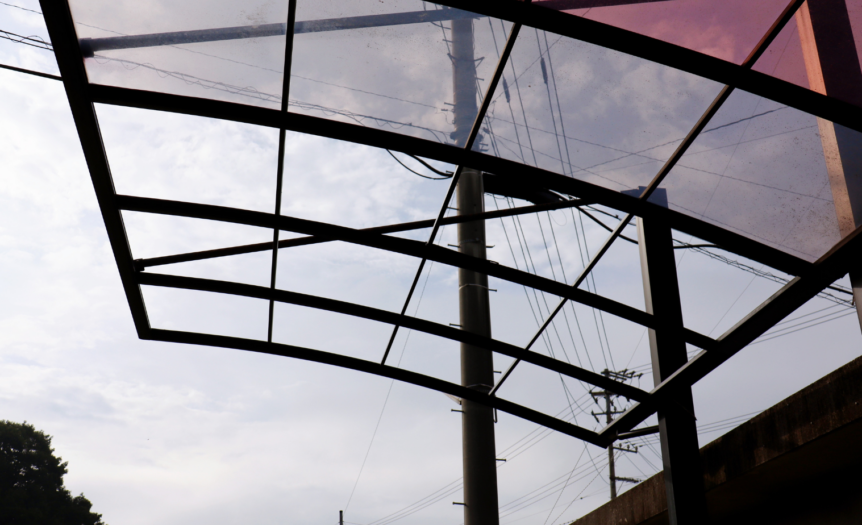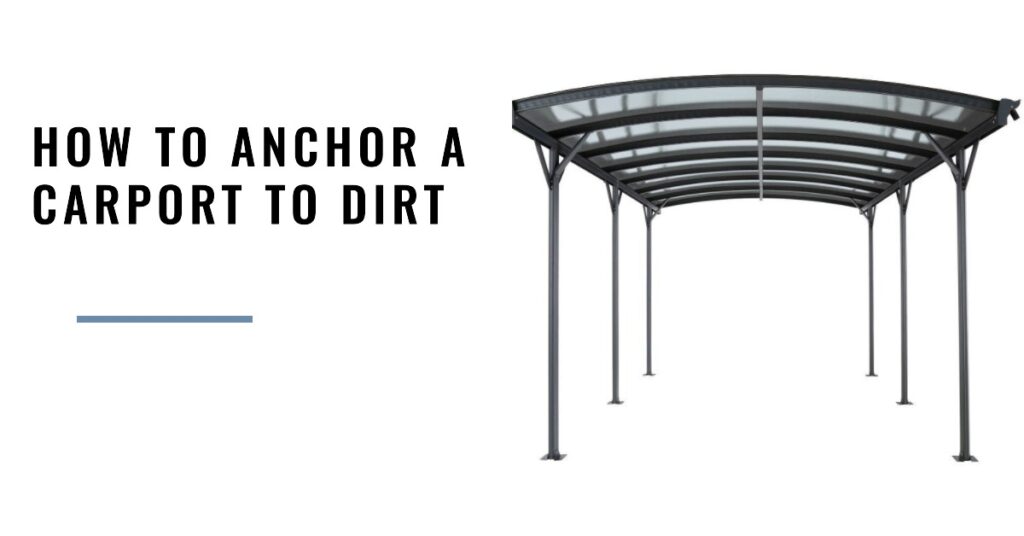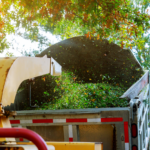Carports are the perfect solution for protecting your vehicles from the elements, but securing them to dirt surfaces can be a challenge. In this comprehensive guide, we’ll cover why it’s essential to anchor your carport correctly and discuss various anchoring techniques suitable for different soil compositions.
From rebar anchors to auger anchors and everything in between, our step-by-step instructions will walk you through the process of safely and effectively securing your carport on dirt.
Key Takeaways
- Properly anchoring a carport to dirt is crucial for ensuring safety and stability of the structure and protecting it from harsh weather conditions.
- There are various types of anchors suitable for different soil compositions, such as rebar anchors, mobile home (auger) anchors, earth augers, concrete footers and trenches and piers.
- It’s important to follow local regulations and building codes when installing a carport on dirt, including clearing the area, marking anchor locations accurately, leveling the carport correctly before proceeding with preparing materials needed like shims or spirit level tool if required.
- Anchoring connections should be periodically checked after installation to ensure that all connections are secure.
Why Is It Important To Anchor A Carport To Dirt?
Anchoring a carport to dirt is important for ensuring the safety and stability of the structure, as well as protecting it against harsh weather conditions and other external elements.
Ensuring Safety And Stability
One of the primary reasons to anchor a carport to dirt is ensuring safety and stability for your vehicle and belongings. Without proper anchoring, the carport can easily sway or even topple over due to strong winds, storms, or uneven soil conditions.
For example, imagine you’ve installed a metal carport on loose soil without any ground anchors – this structure would be susceptible to shifting or collapsing when faced with high wind loads.
On the other hand, if you follow appropriate anchoring methods in line with local regulations and building codes, your carport can withstand harsh weather conditions while maintaining its structural integrity.
Protection Against Weather And Other Elements
One of the main reasons why it is important to anchor a carport to dirt is for protection against weather and other elements. A securely anchored carport can withstand strong winds, heavy rain, snow, and other types of extreme weather conditions.
In addition to protecting your carport from harsh weather conditions, anchoring also helps keep pests and debris out. When a structure is not firmly anchored to the ground, wind and rain can easily push pests like rodents into small gaps between the structure and the ground.
Types Of Anchors For Anchoring A Carport To Dirt
Discover the different types of anchors used for securing a carport to dirt, including rebar anchors, mobile home (auger) anchors, earth augers, concrete footers and trenches and piers.
Rebar Anchors
Rebar anchors are a popular choice for anchoring carports to dirt. These steel anchors are typically 20 inches long and provide excellent reinforcement for the structure.
With their ability to penetrate deep into the ground, they offer great stability and wind resistance. Many manufacturers include rebar anchors in their carport installation kits, making it easy to secure the structure onto the ground.
However, it is important to ensure that there is no dirt or debris in the holes before placing post anchors or pouring concrete.
Mobile Home Anchors (Auger Anchors)
One of the most recommended types of anchors for anchoring carports on dirt or soil is mobile home anchors, also known as auger anchors. They are designed to be used with mobile homes and other structures that need to withstand high winds and harsh weather conditions.
Auger anchors feature a corkscrew design that helps them penetrate deep into the ground, providing maximum stability and support for your carport. Made from heavy-duty materials like steel or galvanized metal, these anchors can endure extreme weather conditions and resist corrosion over time.
Earth Augers
Another effective way of anchoring a carport to dirt is by using earth augers. These are spiral-shaped anchors that screw into the ground, creating a stable foundation for the carport.
They can be used on all types of soil and have proven to be incredibly reliable in ensuring carport stability against varying weather conditions.
Home improvement centers offer various types of earth augers suitable for different soil compositions and carport weights. It is important to choose the right size and type based on your specific needs to ensure maximum stability and safety.
When installing earth augers, it is recommended to dig holes with an appropriate tool like a power drill or manual post hole digger and attach the anchor directly to each supporting leg of the carport using bolts or cable ties.
Concrete Footers
Concrete footers are another option for anchoring a carport to dirt. These footers involve digging trenches around the perimeter of the carport and pouring in concrete. The carport legs are then placed into these trenches and secured with bolts or anchors.
One advantage of using concrete footers is that they eliminate the need for individual post holes, resulting in a more uniform appearance. However, this method requires more labor and materials compared to other anchor types, which can increase installation costs.
Trenches And Piers
Trenches and piers are another option for anchoring a carport to dirt. Trenches are dug around the perimeter of the carport, and concrete is poured into them to create a solid foundation.
Piers, on the other hand, involve digging holes at specific intervals along the length of each side of the carport and installing concrete pillars in them.
Trenches and piers are suitable for areas with softer soils that can’t support heavy loads. While they require more preparation work than some of the other anchoring methods, they’re also more durable once installed.
Materials And Preparation Needed For Anchoring A Carport To Dirt
To ensure a secure and stable carport installation on dirt, proper materials and preparation are necessary, including clearing the area, marking anchor locations, leveling the carport, and having required tools and materials; continue reading for a step-by-step guide.
Clearing The Area
Before starting to anchor your carport to dirt, it is crucial to clear the area where you plan to erect it. This involves removing all debris, rocks, and other materials that can interfere with the anchoring process.
After clearing the area, mark off where each leg of the carport will be placed using stakes or markers. Make sure that each placement is levelled and aligned correctly for stability purposes.
Once marked out, proceed with preparing the ground for anchoring by digging holes for post anchors or footers if necessary.
Marking Anchor Locations
Before starting the anchoring process, it is important to mark the precise locations of where the anchors will be inserted. You can do this by measuring and marking each spot with spray paint or chalk.
The markings should correspond precisely to the anchor positions on your carport frame. This step ensures that you have an accurate point of reference and prevents installation mistakes that may occur due to inaccurate placement.
It is critical to ensure that all measurements are correct, as misaligned anchors could compromise stability and safety in high winds or severe weather conditions.
It’s important also to keep in mind local building codes when designing your carport structure; many municipalities dictate specific requirements for anchoring outdoor structures like carports, so be sure to research these regulations before beginning any work.
Leveling The Carport
Before anchoring your carport to dirt, it’s important to make sure that the structure is level. This will ensure proper weight distribution and stability for the carport.
To level the carport, begin by placing a spirit level across each of the legs of the structure.
Another option is to use shims under any uneven legs to achieve a level surface. Shims can be made from wood or other materials and are placed under one end of a leg that needs adjustment until it becomes even with its counterpart on the opposite side.
Properly leveling your carport before installation will ensure safety and longevity for years to come, giving you peace of mind knowing your vehicle or equipment is protected from weather elements or accidents caused by instability due to unlevel ground.
Required Tools And Materials
To anchor a carport to dirt, you will need a few essential tools and materials. The first step is to clear the area where your carport will be installed. This includes removing any rocks, debris or plants that may interfere with the placement of your anchors.
To insert anchors into the ground, you’ll need an auger bit which can be attached to a handheld drill or electric drill if available in your toolbox. A sledgehammer may also come handy for pounding rebar stakes into compact soil before attaching them to metal legs on opposite sides of each pole.
Leveling becomes crucial; thus requires a spirit level tool which determines whether the posts are plumb left-to-right and front-to-back such that they stand vertically along their length.
Step-by-Step Guide For Anchoring A Carport To Dirt
To anchor a carport to dirt, start by digging holes at each of the four corners where you’ll install the anchors using an auger or post hole digger.
Digging Holes And Inserting Anchors
The first step to anchor your carport to dirt is digging holes and inserting anchors. Before digging, make sure you have all the necessary tools, including a shovel, post-hole digger, sledgehammer, and other safety equipment.
Start by clearing the area where you want to install the carport and mark anchor locations. Then start digging holes for each of the posts or insert concrete footers if required.
Next, insert the chosen type of anchor into each hole until it reaches its desired depth.
Once you have inserted all your anchors into the ground or concrete footings, it’s time to connect them with your metal carport legs using bolts provided by manufacturer instructions carefully.
Tighten down all bolts with a wrench adjusting them adequately so that they are stable enough against wind loads requirements while still giving enough flexibility for an earthquake if need be.
Connecting Anchors To Carport Legs
Once you’ve inserted the anchor into the ground, it’s time to connect it to the carport legs. Start by placing a washer over the bolt on top of the anchor and slide it through the hole on one of the carport legs.
Add another washer onto the other side of that leg before tightening a nut over both washers.
Anchoring a carport correctly is crucial for stability and safety, especially in areas prone to windy or severe weather conditions. Using appropriate anchoring techniques like rebar anchors or auger anchors can give your carport extra support from below while ensuring that it remains firmly anchored to dirt or soil beneath it.
Tightening Anchors For Stability
Once the anchors are inserted into the holes and firmly in place, it’s important to tighten them for stability. This can be done by using a wrench or socket set to turn the nuts on top of each anchor clockwise.
Tightening the nuts will help secure the carport and prevent it from shifting during harsh weather conditions like strong winds or heavy rain. It’s important not to overtighten the anchors as this can damage both the structure and anchors themselves.
It is also recommended that you periodically check your carport after installation to make sure that all connections are still secure, especially after extreme weather conditions.
Tips For Successful Carport Anchoring
Follow local regulations and building codes, use proper tools and safety equipment, choose the right anchor type for soil and carport type, and follow manufacturer’s instructions carefully to ensure successful carport anchoring.
Follow Local Regulations And Building Codes
It is important to follow local regulations and building codes when anchoring a carport to dirt. Depending on your location, there may be specific requirements for how deep the anchors must be installed or what type of anchors are allowed.
Failure to comply with these regulations could result in safety hazards or legal penalties.
For example, some areas require that carports be anchored using concrete footers dug below the frost line to prevent shifting during freeze-thaw cycles.
By following these guidelines, you can ensure that your carport is not only stable but also legally compliant with your locality’s standards.
Use Proper Tools And Safety Equipment
To ensure the safety of both yourself and your carport, it is essential to use proper tools and safety equipment when anchoring. This includes gloves, eye protection, a sledgehammer or mallet for driving anchors into place, and appropriate drill bits for pre-drilling holes in concrete footers if necessary.
It’s also important to choose the right type of anchor for your carport and soil composition.
In addition to using the correct tools and equipment, following manufacturer’s instructions carefully can prevent any issues that could arise during installation.
Choose The Right Anchor Type For Soil And Carport Type
Choosing the right anchor type is crucial when it comes to anchoring your carport to dirt or soil. The type of anchor you choose will depend on various factors like the soil composition, your geographic location, and the kind of carport you have installed.
On the other hand, if you have a relatively small metal carport that needs anchoring and are looking for a simple DIY solution, rebar anchors might work best for you. Knowing which type of grounding tool to use can also prevent damage to your brand new outdoor structure from shifting and settling over time.
Follow Manufacturer’s Instructions Carefully
It’s essential to read and follow the manufacturer’s instructions carefully when anchoring a carport to dirt. Different brands may have different requirements and recommendations, so it’s crucial not to assume that all anchors are the same.
Failing to follow the manufacturer’s directions could lead to structural problems or instability in extreme weather conditions. For example, using an incorrect tool or fastener might damage the structure during installation.
By following the right steps as per manufacturers’ recommendations, you can ensure that your carport will stay stable in strong winds or heavy rainfall without any issues over time.
Conclusion
Anchoring a carport to dirt is an important step in ensuring safety and protecting against weather elements. With various types of anchors available, including rebar anchors, mobile home anchors, earth augers, concrete footers, trenches and piers, you can choose the best one for your carport and soil type.
Make sure to follow local regulations and building codes while preparing your materials such as leveling the carport and marking anchor locations. By using proper tools such as sledgehammer or steel anchors and following manufacturer instructions carefully, you can anchor your carport successfully with stability against wind load resistance.
FAQs:
1. What are the benefits of anchoring a carport to dirt?
Anchoring a carport to dirt provides stability and security for your structure, preventing it from shifting or toppling over in windy conditions or during natural disasters.
2. What materials do I need to anchor my carport to dirt?
The materials required will depend on the size and type of carport, but typically you’ll need heavy-duty stakes, steel cables, concrete or gravel for creating footers, and a post-hole digger or auger.
3. How should I prepare the site before anchoring my carport to dirt?
Before installing anchors, you should clear any debris from the site such as rocks or large sticks that may interfere with digging holes. You may also want to level out the area if necessary by adding gravel or compacting soil.
4. Can I hire a professional to anchor my carport instead of doing it myself?
Yes – it is highly recommended that individuals who are not experienced in construction work with professionals when trying install anchors otherwise injuries could result due lack knowledge/skills involved which make them dangerous tasks without proper tools & protective gear in place.







